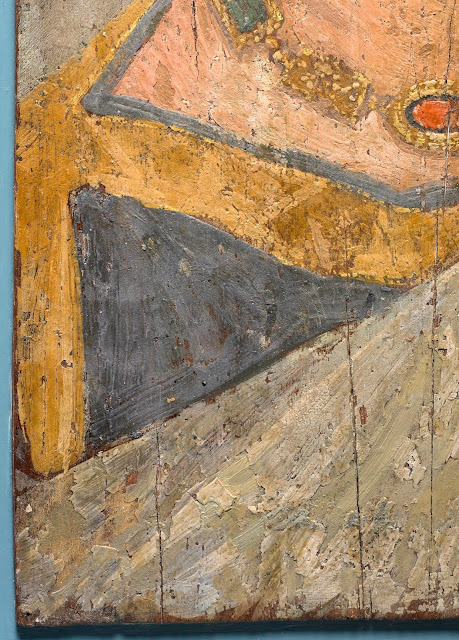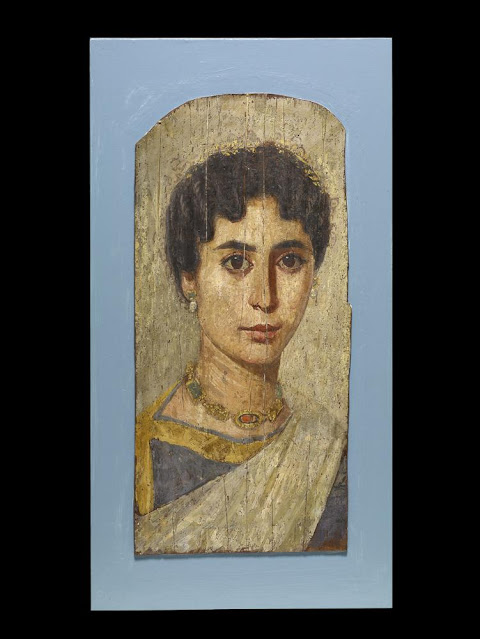There are lots of such portraits! (s. here) It seems that it was a favourite pastime back then. Or a try to leave a beautiful reminder behind? Here is one of these beauties; let’s enjoy reading this brilliant explanation by Marie Grillot. 🙏💖
Portrait d’une femme distinguée du Fayoum via https://egyptophile.blogspot.com/

Mummy portrait of a distinguished woman – encaustic painting on linden and gold leaf
Roman Egypt – 2nd century (160-170)
Provenance: Er-Rubayat – Acquired from Theodor Graf by Robert Ludwig Mond
who bequeathed it in 1939 to the British Museum – EA65346 – photo © The Trustees of the British Museum
Her “class”, distinction, and nobility have stood the test of time: beautiful and elegant during her lifetime, she will remain so for eternity …
Her gaze is frank and straight, even if, on scrutinizing it more closely, his large brown eyes seem to hide an unfulfilled question deep within them. The round, dark iris stands out from the white gaze, which looks slightly damp. It is animated by a subtle dot of white paint, giving it a spark of life. Thin and short eyelashes are treated individually. The eyebrows, with well-defined implantation, follow the shape of a circumflex accent.
The nose is delicate and straight; its edge is underlined by a more marked paint touch. The furrow’s hollow leading to the lips is surrounded by a light white line.

Mummy portrait of a distinguished woman – encaustic painting on linden and gold leaf
Roman Egypt – 2nd century (160-170)
Provenance: Er-Rubayat – Acquired from Theodor Graf by Robert Ludwig Mond
who bequeathed it in 1939 to the British Museum – EA65346 – photo © The Trustees of the British Museum
The mouth is attractive with its lips with a cupid’s arch asserted and with their fine labial commissures. Tinted with a discreet pink, they seem to want to sketch a smile …
The brown hair, nicely wavy, leaves the part of the forehead visible. It’s gathered certainly, in a bun at the neck’s nape and is adorned with a thin gold crown or a tiara. This is not the only adornment. Indeed: “The woman wears square emerald earrings set in gold with pearl pendants. Around her neck is a heavy necklace composed of a large emerald in a rectangular frame and a large one. Red oval stone, possibly carnelian, flanked by two rectangular gold plaques. All the frames are made in gold leaf “.

Portrait of a mummy representing a distinguished woman: detail of the necklace and clothing
encaustic painting on lime and gold leaf – Roman Egypt – 2nd century (160-170)
Provenance: Er-Rubayat – Acquired from Theodor Graf by Robert Ludwig Mond
who bequeathed it in 1939 to the British Museum – EA65346 – photo © The Trustees of the British Museum
This distinguished woman, who poses elegantly three-quarter length, obviously had as much taste for choosing her dress as her jewellery… “Her clothes are most unusual: a blue-purple tunic, with a golden clavus that continues in a decorative band under the neck where it is edged with gold leaf; and over the shoulder, a creamy white coat, almost the same colour as the background, is draped in the manner of contemporary statuary “(extracts from” Ancient Faces: Mummy Portraits from Roman Egypt “, Susan Walker and Morris Bierbrier).
She lived in the 2nd century AD and undoubtedly belonged to a wealthy class, perhaps even the elite. Indeed, only the wealthiest could afford quality funeral rituals. After having been Greek, Egypt became Roman… and cosmopolitan: Egyptians, Greeks and Romans mingled. The new “masters of the land” adopted the funeral customs of Pharaonic Egypt, and the Romans introduced the art of portraiture.

Roman Egypt – 2nd century (160-170)
Provenance: Er-Rubayat – Acquired from Theodor Graf by Robert Ludwig Mond
who bequeathed it in 1939 to the British Museum – EA65346 – photo © The Trustees of the British Museum
This type of portrait was produced during the model’s lifetime by itinerant painters who never signed their works … Even if they remained in anonymity, have been they then “known”, renowned? We whispered the name of the best, the most talented; was it “good taste” to be “immortalized by so and so? These questions keep their question marks …
The support for these portraits – which will, during mummification, be placed on the face of the deceased – is most often a plank of wood (lime, fig, cedar or sycamore) which has been smoothed and coated beforehand. The sketch is then executed in red or black. “Then, the portrait was carried out using mineral and vegetable pigments bound with heated wax (encaustic), which allows a slow and meticulous work resulting in small close touches for the face. On the other hand, the neck, the hairstyle and the clothing are treated with broad strokes of the brush “.

Roman Egypt – 2nd century (160-170)
Provenance: Er-Rubayat – Acquired from Theodor Graf by Robert Ludwig Mond
who bequeathed it in 1939 to the British Museum – EA65346 – photo © The Trustees of the British Museum
44.2 cm high and 20.7 cm wide, painted “with encaustic”, on a linden board, this portrait called “of Fayoum ‘” comes more precisely from Er-Rubayat, north of Hawara. In “Ancient Faces: Mummy Portraits from Roman Egypt”, the authors specify that: “The portraits associated with the cemetery of Er-Rubayat were mainly acquired in the 1880s by the Viennese merchant Theodor Graf, who exhibited them in several places in Europe and America, acclaimed by the public, selling them to various institutions and private collectors… “.
This is the case with the generous patron Robert Ludwig Mond (Farnworth, UK, 9-9-1867 – Paris, 22-10-1938), then bequeathed to the British Museum. He entered it in 1939 under the number EA65346.
Sources:
Mummy-portrait – EA65346
https://www.britishmuseum.org/collection/object/Y_EA65346
Eternal Egypt: Masterworks of Ancient Art from the British Museum Paperback, 2001, English edition, Editing by Edna R. Russmann
Ancient Faces: Mummy Portraits from Roman Egypt by Susan Walker, Metropolitan Museum of Art https://books.google.fr/books?id=t9RM6G-nHOoC&printsec=frontcover&hl=fr&source=gbs_ge_summary_r&cad=0#v=onepage&q&f=false
The mute apostrophe – Essay on the portraits of Fayoum, Jean-Christophe Bailly


What an absolutely fascinating article! Thank you Aladin for sharing another of Marie’s detailed explorations. Wow! I love the very idea of having one’s portrait painted on a tree board back in the 2nd century and then placed on one’s face after death and mummification. The painting Marie explores looks almost contemporary, like a person of royal heritage or great wealth. Hope all’s well with you. Love and light, Deborah.
LikeLiked by 1 person
Absolutely agree! We can admit that these works are extraordinary arts. Thank you, my dear angel. 🙏💖
LikeLiked by 1 person
the thing that struck me about her are, or were, how soft and gentle her eyes look. 😉
LikeLiked by 1 person
Oh yes, brother. One can fall in love with them. 😉🙏
LikeLike
Those eyes are amazing!
LikeLiked by 1 person
Oh… yes… 😜😎🥰🙏💖
LikeLiked by 1 person
Fascinating! Apart from her eyes I am attracted to the details of the necklace. Gorgeous.
LikeLiked by 1 person
An excellent point of view! A feminine observation. 🙏💖🙏🥰😘
LikeLike
Stunning!
LikeLiked by 1 person
Oh yes! Agreed 🤗🙏❤️
LikeLiked by 1 person
Beautiful, historical, and so interesting. It makes me think of the many photos we take now and what we do with them after death. One of the friends who stayed with me (and Vic) while Vic was dying asked if I wanted him to take photos. I did. I love the photos where Vic is healthy and vital, but there’s power in the range from baby pictures to a death photo. Thank you for sharing this gorgeous painting and the history. We didn’t turn Vic into a mummy, but we put a few photos in his cremation box.
LikeLiked by 1 person
I thank you for telling such a heartfelt part of your memories, dear Elaine ❤️ 🙏
LikeLiked by 1 person
I enjoyed your reflections on the artwork. It’s divine!
LikeLike